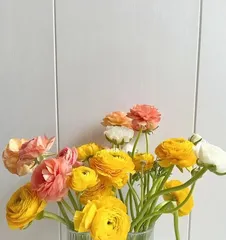As an elegant and noble flower, ranunculus is widely used in gardens and indoors. However, for many people who love growing flowers but are not very familiar with ranunculus, how to keep these beautiful flowers alive for a long time is a challenge.

I. Selecting Healthy Ranunculus Seedlings
When buying ranunculus seedlings, choose healthy and well-growing ones. You can judge whether a plant is healthy by observing the color of its leaves, the strength of its stems, and the number of flower buds.
II. Suitable Light Conditions
Ranunculus has high requirements for light, but direct sunlight can damage the plant. It is best to place the plant in a semi-shady place and avoid strong direct sunlight.

III. Appropriate Temperature and Humidity
Ranunculus likes to grow in a warm and humid environment. Pay attention to maintaining suitable temperature and humidity around the plant. In the hot summer season, you can adjust indoor humidity by spraying water or using a humidifier.
IV. Regular Watering
Ranunculus needs sufficient water to maintain normal growth and development. However, be careful not to overwater or underwater, as this can damage the plant. Generally, watering once or twice a week is sufficient.
V. Reasonable Fertilization
Ranunculus has relatively rich nutritional needs, so it needs appropriate fertilization. You can fertilize during the growing and flowering periods, but be careful not to over-fertilize, as this can harm the plant.

VI. Pruning in a Timely Manner
Ranunculus grows relatively fast and is prone to developing overly long or abnormal branches and leaves. You can prune it in time to maintain the plant's beautiful shape and at the same time promote the growth of new flower buds.
VII. Regular Repotting
The root system of ranunculus is relatively developed and can easily fill the pot soil. It is necessary to repot the plant regularly, while removing old soil and withered roots.
VIII. Pay Attention to Pest Control
Ranunculus is susceptible to pests such as aphids and mites. You can use professional pesticides to control pests, but pay attention to the dosage and frequency to avoid harming the plant.
IX. Suitable Propagation Methods
Ranunculus can be propagated by methods such as division, cuttings, and grafting. Choose a suitable propagation method and carry it out at the right time and in the right environment to ensure a high success rate.
X. Pay Attention to Avoiding Drought During Dormancy
Ranunculus has a dormant period during which the plant is dormant. However, pay attention to avoiding drought. You can maintain the humidity around the plant by regular watering or using a humidifier.
XI. Preventing Parasitic Plants
Ranunculus is susceptible to invasion by some parasitic plants, such as orchids. It is necessary to inspect the plant regularly and remove parasitic plants in time to keep the plant healthy.
XII. Avoiding Mechanical Damage
When performing operations such as pruning and repotting, pay attention to avoiding mechanical damage. You can use sharp tools and disinfect them before operation to avoid harming the plant.
XIII. Regularly Checking the Roots
The roots of ranunculus can easily grow too densely, so it is necessary to check the condition of the roots regularly. You can appropriately remove withered roots and strengthen care to ensure the healthy growth of the plant.
XIV. Timely Treatment of Diseases
Ranunculus is susceptible to some diseases such as brown spot disease and gray mold. It is necessary to detect and treat these diseases in time to avoid serious harm to the plant.
XV.
Caring for ranunculus is not a simple task and requires a lot of knowledge and skills. However, as long as you care for them in the right way and following the proper steps, these beautiful flowers can live for a long time and bring endless joy and surprise.